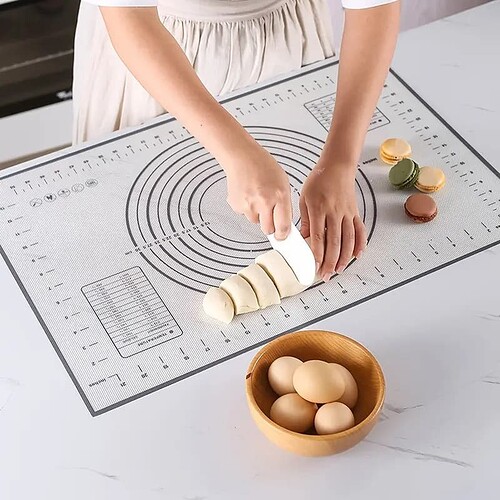Would like to hear about replacing baking paper with silicone mats and silicone baking pans, etc. Is the testing (for health) adequate in Australia and are there brands already found superior in performances, cleaning etc?
It would be interesting to hear from those using the products, what is baking and the results.
Puzzled, as silicone rubber is a good insulator?
A metal cake tin, or thin baking paper conduct heat effectively. It seems counter intuitive.
I’ve silicone rubber egg rings for poached eggs the traditional Aussie way in a pan simmering water. They don’t hold their shape in storage. I still prefer the aluminium egg rings. I’ve seen others use silicon rubber for cup cakes, which are usually done in paper. Speculation is the paper cups help to keep the cup cakes fresher while the batch size can be quite large for only a few cents a cake.
Choice has not mentioned health risks of silicone bakeware. The article does not mention brands.
After some searching I cannot find any studies that show there is a health problem. The closest I can find are claims that some silicone emits siloxanes at high temperatures. Siloxane is not generally regarded as a risk to health and are used in biomechanical appliances where they are generally considered to be inert.
There are many articles on the web urging caution but I cannot find any that show evidence of harm. Often the reluctance to use it is mixed in with criticism of it not being recyclable or biodegradable, but that does not mean it is harmful to health.
Given the this stuff has been around for quite some time and the motivation for some to find health problem coming from synthetics the lack of evidence suggest there may be nothing to find.
Australian suppliers supposedly rely on the FDA Standard as the minimum for food grade silicon rubbers. The latest version of AS2070 has been updated/harmonised to recognise FDA standards. How this may relate to silicone rubber products, the AS is not a public document.
We use some cheap mats we bought many years ago. They work okay but lighter colour ones discolour slightly where the biscuits sit. The discoloration doesn’t impact on the ongoing performance. One if ours looks a bit like this
where decals are also useful. We use this one for kneading etc as well. These can be bought online for a few dollars. We have also recently bough some flat baking sheets from Kmart and they suffer discolouration over time as well.
There are also precut mats which fit round at square tins, for loaves/cakes. We bought some cheap ones from Kmart to give them a try. They work well, except since the mats are flat where baking tins aren’t, sometimes it can be challenging to get the mats to sit within a tin to have a perfectly shaped loaf/cake (noting it still tastes the same even if it isn’t perfect).
The mats also feel greasy after washing from butter/oil in the mixture being baked.
Silicone mats also have a maximum temperature for cooking which is on packaging (or on some mats). This is something to think about if you bake in a very hot oven.
Most baking paper is coated in silicone, so since you have used baking paper, you should have no concerns about using silicone mats.
The final comment is silicone is a plastic. But mats are reusable many times, while baking paper is single use - so better for the environment if they are looked after and ultimately replace many rolls of baking paper.
Not gratis, if one pays one gets, I didn’t.
As far as it might go with food grade silicone rubber products. It looks like we are reliant on imported product. Hence knowing the standard/s or details is of little value to the average consumer. We’re in the hands of the importer, their due diligence and how/where they purchase from.
There are food grade and not food grade silicone rubbers. Hence some scope for things to go wrong. Perhaps less risk to buy from a recognisable Aussie retailer than some mystery seller on line?
If there are risks with a product not meeting food grade, it’s what else might have been added or through contamination of the product.
